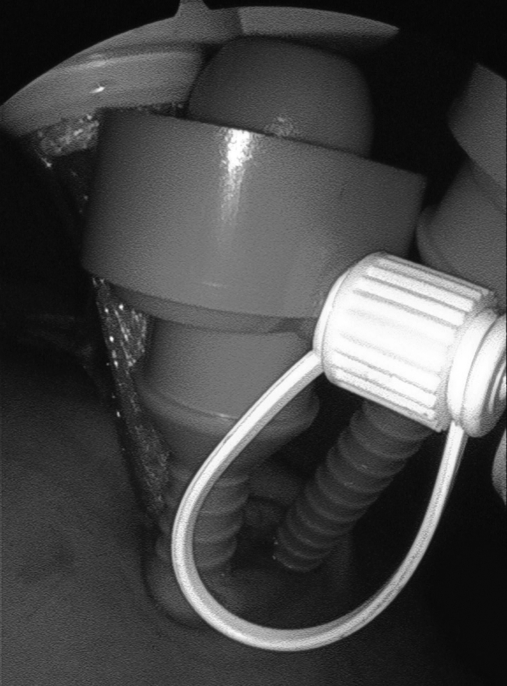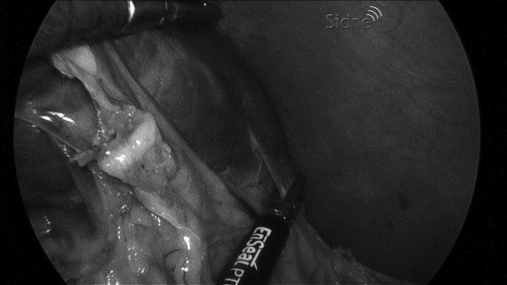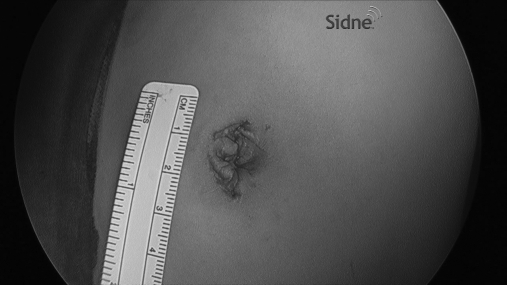Laparoscopic splenectomy in a pediatric patient was performed through a single umbilical incision by using 3 ports.
Keywords: Single incision, Laparoscopy, Splenectomy, Child
Abstract
Background:
Single incision laparoscopic surgery (SILS) is an emerging technique that has been used as an approach for appendectomy, cholecystectomy, and splenectomy. We describe the technique of single incision laparoscopic splenectomy for hypersplenism in a 5-year-old boy with spherocytosis.
Case Report:
The patient required blood transfusions for anemia secondary to hypersplenism. His spleen measured 9.8 cm in cranio-caudal length on ultrasound. SILS splenectomy was performed through a 2-cm umbilical incision by using 3 ports. The splenic attachments were taken down using an electrosurgical sealing and cutting device, and the hilum was transected with an endosurgical stapler. The spleen was placed in an endosurgical bag, morcellated, and removed from the abdomen via the umbilical incision without complications. Operative time was 84 minutes; blood loss was minimal.
Conclusion:
SILS splenectomy is feasible in pediatric patients. More experience is needed to assess advantages and disadvantages compared with the standard laparoscopic approach.
INTRODUCTION
Single incision laparoscopic surgery (SILS) is an emerging endosurgical approach in which the entire operation is performed through abdominal trocars placed via a single skin incision in the umbilicus. It has been used successfully for both appendectomy and cholecystectomy. So far, splenectomy using this technique has been reported in 2 adult patients.1 We describe single incision laparoscopic splenectomy in a 5-year-old boy with splenomegaly and hypersplenism secondary to hereditary spherocytosis.
CASE REPORT
A 5-year-old boy with hereditary spherocytosis who had begun to require blood transfusions for symptomatic anemia was referred for splenectomy. Abdominal sonography showed splenomegaly with a craniocaudal dimension of 9.8 cm. Preoperative pneumococcal and meningococcal vaccines were given.
The patient was placed supine with the left flank elevated on a 10-cm gel cushion. A 2-cm vertical incision was made through the umbilical skin. The underlying fascia was exposed circumferentially with a radial dimension of approximately 2.5 cm. A small fascial defect was found in the center of the umbilicus through which the Veress needle was introduced to insufflate the capnoperitoneum to a pressure of 14 mm Hg. After insufflation, the defect was closed using a figure-of-eight stitch. A 5-mm camera port was placed in the 7 o'clock position, and 5-mm working ports were placed at 4 and 11 o'clock (Figure 1). Lifting the lower tip of the spleen upward with the left hand, the splenocolic ligament was taken down with a 5-mm EnSeal tissue sealing and cutting device (SurgRx Inc, Redwood City, CA). The spleen was then rotated laterally by tilting the bed left side down. The stomach was grasped with gentle medial and upward traction to facilitate division of the gastrosplenic ligament including the short gastric vessels to the level of the diaphragm. The patient was then tilted right side down, and the spleen was rotated medially, providing access to the splenorenal and splenophrenic ligaments (Figure 2). After dividing the more caudal portions with the EnSeal device, the cranial attachments were taken with a 5-mm hook electrocautery, because this provided a better working angle and finer dissection. With only the hilar vessels remaining, the 7 o'clock trocar was upsized to 12 mm, and the camera was changed to the 4 o'clock position. The caudal tip of the spleen was lifted upward, exposing the hilum, and a 12-mm reticulating endosurgical stapler with a 4.5-cm long vascular load was introduced. The stapler was articulated to a 45° angle, and the open jaws were slid across the hilum (Autosuture Covidien Ltd., Mansfield, MA). Once the stapler head was positioned, it was used to suspend the lower part of the spleen upward, while the left hand grasper was repositioned to elevate the cranial portion of the spleen. The hilum was divided with a single firing of the stapler. Subsequently, the 12-mm trocar was removed and exchanged for a 15-mm endosurgical retrieval bag that was introduced directly through the fascia without a trocar. The spleen was “scooped” into the bag with the help of the left hand grasping forceps. Once the bag was closed, all endoscopic equipment was removed. The 3 fascial incisions were connected to create a single fascial incision. The spleen was then morcellated inside the bag and removed in pieces by using ring forceps. The fascial incision was then closed using a running 2-0 polydioxanone (PDS) suture. The skin was closed using subcuticular 4-0 Poliglecaprone (Monocryl) suture (Figure 3). There were no intra- or postoperative complications, and the patient was discharged home on postoperative day 2.
Figure 1.
Trocar positioning in the umbilical incision.
Figure 2.
Division of the splenophrenic ligament. Note parallel alignment of instruments.
Figure 3.
Umbilical incision after closure.
DISCUSSION
Because the navel is a natural scar, single incision laparoscopic surgery (SILS) is attractive in that it results in a virtually scarless operation. Scarless surgery has been the appeal of natural orifice transluminal endoscopic surgery (NOTES) as well. Currently, both of these new approaches are mostly performed in the adult population, and a state-of-the-art review of SILS and NOTES for cholecystectomy was published recently.2
Pediatric surgeons have performed laparoscopic splenectomy for well over a decade3 and have developed extensive experience, resulting in a conversion rate of around 2% and a total complication rate of around 11%.4 This is the standard against which newer operative approaches, including SILS splenectomies in children, should be compared.
The previously described SILS splenectomies were in young adult females (22 and 28 years of age) with idiopathic thrombocytopenic purpura.1 The initial trocar placement was similar to what we used, with three 5-mm trocars in a 2-cm vertical umbilical incision. In contrast to this report, we did not use reticulating graspers or instruments except for the endosurgical stapler, because we have not found a clear advantage over straight instruments in our single-site laparoscopic approach to appendectomy, cholecystectomy, and pyloromyotomy. Our operative time of 84 minutes was shorter than the previously reported adult cases (110 and 150 minutes, respectively).
SILS poses significant ergonomic challenges. Grouping all 3 trocars into the same incision leads to spatial interference of the camera and working instruments. The freedom of motion can be improved by spacing the ports in the periumbilical fascia as far away from each other as possible. Furthermore, the trocars should be introduced at different depths, so that collision of the valve heads is minimized. Additionally, using instruments and a camera of different lengths, minimizes interference of the surgeon's and assistant's hands. An angled scope is essential. Compared with our standard laparoscopic approach, no special instruments were required for the SILS procedure. Using a tissue sealing electrosurgery device and a vascular stapler for the splenic hilum minimized the operative blood loss, which was recorded as <10 mL.
We recommend that during a SILS procedure, the surgeons are ready to introduce additional trocars to aid in visualization, dissection, or reconstruction if they perceive that a maneuver cannot be performed safely for the patient through a single incision. In our practice, we always have additional trocars ready to convert to dual incision laparoscopic surgery (DILS) or standard laparoscopy anytime.
Although some dissection of the splenic attachments was slightly more cumbersome than during the standard laparoscopic procedure, we did not encounter any moment where we perceived an increased risk to the patient because of the SILS approach. Using a tissue sealing electrosurgery device and a vascular stapler for the splenic hilum minimized the endovascular blood loss, which was recorded as <10 mL. The splenic hilum was well dissected before the endostapler was applied, and only one 4.5-cm vascular load was required. The SILS approach did not seem to compromise our visualization or the ability to identify accessory spleens.
Compared with our standard laparoscopic approach, no special instruments were required for the SILS procedure, so that there is no economic disadvantage using SILS. Subjectively though, operating time may have been increased by placing all trocars in the umbilicus, although this remains to be shown once we have a larger series for comparison.
Our report shows that single-incision splenectomy is feasible even in young children. Further experience with this evolving technique is needed to determine specific risks and benefits.
Contributor Information
Erik N. Hansen, Division of Pediatric Surgery, Children's Hospital of Alabama, University of Alabama at Birmingham, Birmingham, Alabama, USA..
Oliver J. Muensterer, Division of Pediatric Surgery, Children's Hospital of Alabama, University of Alabama at Birmingham, Birmingham, Alabama, USA..
References:
- 1. Barbaros U, Dinççağ A. Single incision laparoscopic splenectomy: the first two cases. J Gastrointest Surg. 2009;13(8):1520–1523 [DOI] [PubMed] [Google Scholar]
- 2. Chamberlain RS, Sakpal SV. A comprehensive review of single-incision laparoscopic surgery (SILS) and natural orifice transluminal endoscopic surgery (NOTES) techniques for cholecystectomy. J Gastrointest Surg. 2009;13:1733–1740 [DOI] [PubMed] [Google Scholar]
- 3. Esposito C, Corcione F, Ascione G, Garipoli V, Di Pietto F, De Pasquale M. Splenectomy in childhood. The laparoscopic approach. Surg Endosc. 1998;12:1445–1148 [DOI] [PubMed] [Google Scholar]
- 4. Rescorla FJ, West KW, Engum SA, Grosfeld JL. Laparoscopic splenic procedures in children: experience in 231 children. Ann Surg. 2007;246:683–687 [DOI] [PubMed] [Google Scholar]





